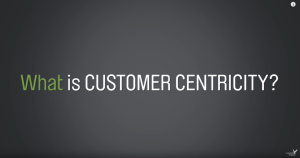As more companies are asking what it takes to provide a customer experience that will set them apart, people are getting hung up on definitions and feeling unsure of where to concentrate their efforts. To differentiate themselves, organizations need to adopt a customer-centric mindset. But how is that different from providing excellent customer service?
What is the Difference Between Customer Service and Customer Centricity?
Customer service is what happens at the front line between someone receiving a product or service, and the business that is providing it. In B2C organizations, this includes the interactions between the paying customer and the business. In B2B companies, customer service most often happens between the end users at the organization making the purchase (individuals and departments), and the provider of the product or service (most often the sales and customer service departments).
Then, what is customer centricity? Customer centricity is a value that informs the behavior of the entire organization. It involves every individual at every level of the organization operating under the assumption that everything they do has the potential to affect the overall experience of the customer. Customer centricity includes customer service, but it doesn’t begin or end with frontline staff. Instead, a customer-centric organization considers the entire customer journey, and anticipates customer needs beyond the single transaction.
Adopting a customer-centric culture can have a tremendous impact on the organization and its employees. In fact, researchers at Forrester found that employees at 93 percent of customer-centric companies are happy to work there, compared to only 20 percent of employees at companies that are less focused on the customer experience. In addition, 95 percent of customer-centric companies said their customers are satisfied with their products and services, compared to only 46 percent of other companies. Meanwhile, a Walker study found that even a moderate improvement to the customer experience can impact the revenue of a $1 billion company by an average of $775 million over three years.
With such an impact on employees, customers, and the organization’s bottom line, it’s easy to see why more companies are putting a focus on customer centricity.
What Do Customer-Centric Organizations Do Differently?
Adopting a culture of customer centricity can be a major shift in mindset for some organizations. By definition, it requires the organization to put the customer at the center of business decisions, and work together to consider the total customer experience at all times. Here are just a few of the ways that customer-centric organizations approach work differently:
1. Place the customer at the heart of all decisions and actions
Customer-centric organizations don’t just promise excellent customer service. They define the customer experience they wish to provide and create policies, frameworks, and procedures to make it happen.
2. Empower individual employees
Customer-centric organizations make sure that every individual knows they can take action to impact the customer experience, and that they know the balance between personal judgment and corporate policy when taking such action. These organizations inspire accountability within their workforces; by giving people the ability to do what needs to be done, each individual is able to take ownership of their part in the customer experience.
3.Communicate effectively
Customer-centric organizations break down silos. They understand that the flow of information between departments and functions has a huge impact on the customer experience – especially when something that “looks good” for the customer’s experience when examined in isolation actually causes friction when considered in the context of the entire customer journey. Open communication helps everyone understand and create the desired customer experience.
4. Obsessed over data
Customer-centric organizations seek out data and use it to improve the customer experience. They watch the market and emerging trends in order to anticipate evolving customer needs. They obtain permission to use customer information to personalize individual interactions. They examine referral rates, customer satisfaction surveys, online reviews, and so on, to understand how effective the organization’s customer experience initiatives really are.
Consider Customer Centricity a Journey
Customer centricity is so much more than just providing good customer service, and becoming a customer-centric organization doesn’t happen overnight. It requires a shift in mindset, new policies, and changes in behavior across the organization. To learn more about customer centricity, the impact it can have on your organization, and how to make the shift, check out Eagle’s Flight founder and CEO, Phil Geldart’s book, Customer Centricity: A Present and Future Priority.


